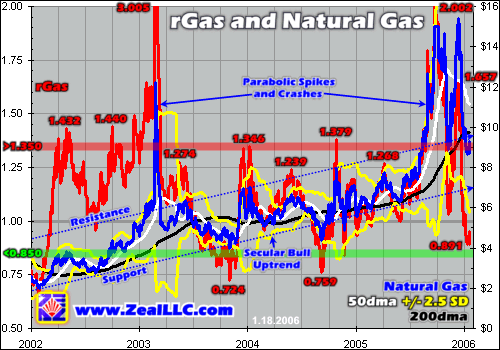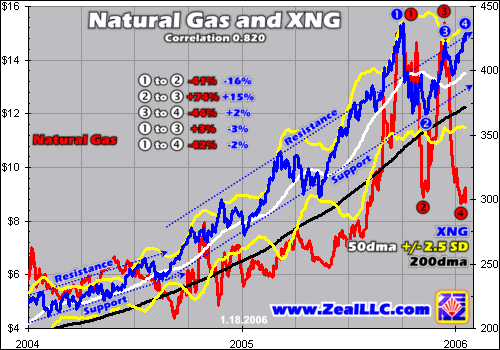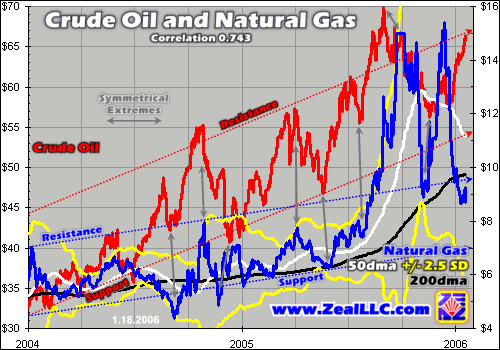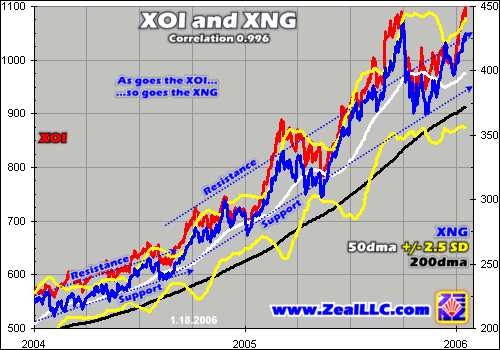|
|
|||||||
|
|
|
|
|
|
|
|
|
|
Tactical Gas Trends Adam Hamilton January 20, 2006 3233 Words
After surging well above $15 per million BTU in mid-December, just one month later natural gas prices have plunged by 44%. While this is certainly a major decline, it is probably not as important as the financial media is leading us to believe. Natural gas is a volatile market and wickedly sharp rallies and plunges are typical.
If you are investing or speculating in natural gas stocks as I am, the crash of gas prices in the last four weeks certainly has the potential to cause concern. After all, if gold plunged 44% in one month then gold stocks would be gutted and left for dead and the financial pain would be enormous. Are gas stocks in trouble today? What about natural gas itself?
As always in the financial markets, the best way to understand prevailing tactical trends is to step back and consider the big strategic picture. When the tactical gas trends in force today are fitted into the prevailing strategic gas trends like pieces to a puzzle, the reasons for the gas crash and its potential implications become readily apparent.
Thankfully neither natural gas nor the companies that produce and transport it are in mortal peril today. In fact they are generally still awesome buys and likely to thrive tremendously in 2006. Our capital deployment into gas stocks is continuing despite the recent volatility in gas. The sharp gas decline we just witnessed is normal and perfectly justified in a strategic context.
I suspect many investors worried about this latest crash fail to realize just how magnificent the natural gas bull market has been in recent years. Since late 2001 natural gas prices had risen a spectacular 806% as of their highs in the middle of last month. But even at their latest interim lows last week, the gas bull-to-date gain was still an amazing 408%! Compared to goldís relatively modest 117% bull-to-date gains, gasís vast potential is really stunning.
Regardless though, a blistering 44% decline in one month is a hard event to ignore. So how on earth can I not be concerned about this latest crash in natural gas prices? Our first chart this week tells this tale. It compares natural gas with Relative Natural Gas, or rGas. rGas is simply the gas price divided by its 200-day moving average. When charted rGas helps highlight the typical magnitude of uplegs and corrections in this bull market.
As you study the blue natural gas line, its most obvious attribute is its tendency to periodically rocket vertically in parabolic spikes. There was one in early 2003 and another spawned by the hurricanes last autumn. While vertical price spikes are certainly fun when you are long, they are never sustainable. In any asset, at any scale, sudden parabolic surges higher are almost always followed by equally sharp crashes.
The reason these vertical spikes are not sustainable is they are driven by emotion, greed, rather than the underlying supply and demand fundamentals. Short of nuclear war it is hard to imagine any fundamental scenario where a particular commodityís supply and demand profile could change so radically and rapidly that it would justify a double or triple over only a few trading days that is sustainable. The supply fears that drive such blistering spikes are never fully warranted and normality rapidly returns ushering in a subsequent crash.
Just as gravity naturally catches up with any object hurled into the air, regardless of how much force is behind the throw, in the markets fundamental gravity always arrests vertical ascents. As fundamentals exert themselves prices going parabolic soon crest and then plummet in sharp crashes until they once again stabilize at fundamentally justified levels. This market law is just about as immutable as gravity. What shoots up must fall down!
Back in early 2003 gas roared above its secular bull uptrend channel like a bullet shot into the air. It rocketed from within its bull uptrend to a stellar peak far above it in just 5 trading days. The very next day it started falling fast as fundamental gravity caught up with it and it only took another 12 trading days or so to once again stabilize under its uptrend resistance back at its launching levels. Parabolic spikes tend to be very short lived.
Fast forward to August 2005, where gasís latest unsustainable parabolic spike started soaring heavenwards. As August began, which was before the hurricanes hit, gas was trading under $8 and well within its bull-market uptrend channel. But prices started to gradually climb as hurricane Katrina gathered strength in the Gulf and became a Category 5 storm over open water. Gas was still under $10, not too far above its uptrend, the trading day before the storm slammed into New Orleans.
But the very next day, as the potential magnitude of the damage to gas infrastructure became apparent, gas soared above $12. It held in this area for three weeks or so as damage assessments started to filter in and a second hurricane approached the Gulf Coast. Then it suddenly spiked up to $15 several weeks after Katrina hit and completed its first parabolic spike of 2005. You will note above that this late 2005 spike persisted much longer than the earlier 2003 specimen.
Why? I think there was real potential for there to be a true fundamental basis underlying the hurricane gas spike. The Gulf Coast region, where much of the domestic natural gas is produced and funneled into pipelines for the rest of the nation, suffered tremendous damage and no one knew how long it would take for normal gas operations to resume. As long as these very real fundamental concerns existed, gas remained above its secular uptrend channel which had formed earlier in the absence of major hurricane disruptions.
Eventually though, gas operations started trending towards normal in the Gulf. As gas supplies came back online and attained a more normal pace, fundamental fears about gas waned and prices soon plummeted. Even though Katrina was a real-world event, not a figment of speculatorsí imaginations, the parabolic gas spike it drove was not sustainable because the storms didnít end up radically altering gas production on a long-term basis.
Gas spiked parabolically in late 2005 on the storms, they didnít wreak gas Armageddon as originally feared, so the storm-driven price spike had to collapse and this crash happened in the last month or so. Yes, gas really did fall 44%, but it fell from unsustainably inflated levels driven by a temporary speculative anomaly. Even after its latest crash natural gas still remains comfortably near the top of its bull-market uptrend.
With gasís strong secular trend quite intact to this day, the sharp correction or crash out of late 2005ís parabolic scenario is really nothing to worry about. Gas was driven up far higher than it should have been under normal conditions and it had to retreat back down near more normal levels as the storm disruptions faded. If gasís crash had dragged it under bull support near $7 or so I could see being concerned, but merely taking it back down near its upper resistance is no big deal at all.
Actually, gas looks like a great buy today thanks to its crash. The red line above is rGas, gas divided by its 200dma. At the bottom of major corrections rGas seems to find support near 0.85 or so, the green bar above. Today gas is once again approaching this 0.85x relative buy zone where speculators have been well served bull to date by throwing long gas near these levels. In relative terms gas trading near 0.89x its 200dma today is actually the third best buying opportunity of this entire gas bull to date!
So while a 44% month-over-month decline in gas prices certainly sounds scary on its surface, this time around it is nothing to fret about. Gas had soared parabolic and needed a big correction to restore sentiment balance and again reflect fundamental realities. The resulting crash merely carried it down just under its bull resistance near the top of its secular uptrend. And gas is now undervalued relative to its 200dma baseline.
With gas still looking great on a secular basis despite its recent crash, I would like to take a look at the gas stocks. It is interesting that they did not respond to the gas crash as might be anticipated. Much to their credit, gas-stock investors apparently have realized that a sharp gas correction from a parabolic overbought technical extreme is just a trivial anomaly in the grand scheme of things that is not worth selling over.
As a student of the markets I certainly wholeheartedly agree with this thesis. Anomalies come and go but secular fundamentals, which are very bullish in gasís case, remain. In fact, the US EIA just forecasted average 2006 gas prices to be $9.54, 9% higher than the average 2005 gas prices. Not surprisingly companies in the gas industry ought to thrive in this bullish price environment moving forward.
As I discussed in some depth in late November, the XNG is the premier natural-gas stock index today. Comparing the XNGís performance to that of natural gas in the latter part of 2005 is quite illuminating. While natural gas was plunging 44% and the financial media was having a field day talking about the crash, savvy investors were actually bidding up the prices of elite gas stocks.
As we ought to expect, natural gas stocks certainly have a strong positive correlation with the commodity they produce, transport, and sell. Over the last couple years the daily correlation of the XNG and gas has run about 0.820, which corresponds to an r-square value of 67%. Thus 2/3rds of the daily price action in the XNG stocks ought to be explainable and predictable by daily action in the underlying natural gas prices.
Indeed this was the case when gas first started shooting parabolic in late August. The XNG surged with gas prices and reached its all-time high marked with the number 1 on this chart. As damage reports started emerging out of the storm-raked Gulf region and it wasnít as bad as originally feared, both gas and stocks corrected. But while gas was off a massive 41% from points 1 to 2, the XNG only slid by 16% over this period but still created an excellent buying opportunity.
This low point 2, incidentally, occurred on November 7th for gas and November 10th for the XNG. We started layering in our latest gas-stock campaign on November 15th, after the interim bottom solidified, in our Zeal Speculator alert service. As of the middle of this week our initial gas stock is up 10% since then while some call options on a major US gas producer purchased that same day are 47% higher. We werenít the only speculators attempting to seize this opportunity.
From points 2 to 3 the XNG started climbing again, rapidly ramping 15% above its latest lows at point 2. Meanwhile gas supply disruption fears returned and gas rocketed 74% higher in just 25 trading days. But gas-stock investors again wisely perceived the parabolic gas spike for what it was, unsustainable, so they didnít bid up gas stocks into a speculative frenzy. The gas business is booming even at the $8 gas in the center of its uptrend channel and doesnít need $15 extremes to thrive tremendously.
Gas soon collapsed just as it ought to after any parabolic spike. From points 3 to 4 gas prices plummeted 44% in their infamous crash that is now gaining so much notoriety on the financial-news airwaves these days. While the XNG dipped in sympathy initially, which was probably for tax-selling reasons as investors locked in profits leading into year-end 2005, it started climbing strongly in 2006. During the gas crash of the past month the index was still up 2% as of this week, which is very impressive.
So gas stocksí awesome technical behavior in the midst of all this gas chaos really underscores the point that they are not in jeopardy. I even suspect that today will prove to be a fantastic time to throw long gas stocks when we look back a year from now. The gains in this sector should be awesome in 2006 as gas prices continue to rise in their secular bull uptrend and US gas demand growth continues to exceed domestic supplies.
With the tactical gas trends and the resulting gas-stock behavior explained, I would like to present a couple peripheral charts on natural gas and gas stocks which I find interesting. The first examines the relationship between crude oil and gas while the second looks at the stellar correlation between oil stocks and gas stocks. Both charts offer many insights that ought to prove very valuable for gas-stock investors and speculators.
Crude oil prices and natural gas prices are definitely related. As this chart shows both commodities are in secular uptrends and they tend to have symmetrical extremes, gas tends to be near an interim high or low when oil is and vice versa. This makes sense as more technologies such as gas to liquids mature that allow natural gas to be processed into synthetic crude oil. And oil can be burned in many power plants instead of gas when gas is too expensive. Thus large oil and gas price differentials seem to be temporary and fleeting.
But plenty of short-term differentials do exist. Gasís massive late 2005 price spike, for example, was not even remotely followed by oil in terms of magnitude. While gas almost doubled in its hurricane-spawned parabolic spike, oil was only up about 25% or so. The oil market should virtually always be far less volatile than gas since it is much larger and global.
While liquefied natural gas tanker fleets and ports are growing, for the most part gas markets remain continental in scale at best since it is far more difficult to ship gas across the oceans than crude oil. The oil market remains global mitigating volatility but gas markets are fractured and regional. Thus local disruptions, such as the US hurricanes or Russian gas price hikes, generally donít have a global impact in the natural gas world.
And while the strategic oil and gas trends are symmetrical in many ways, on a daily basis their correlation is not stellar. Running at 0.743 over the past couple years, this yields an r-square for oil and gas of just 55%. So slightly more than half of gasís daily behavior is explainable or predictable by oil and vice versa. This is just not particularly high as far as financial-market correlations go. Oil and gas are certainly strategically related, but tactically gas can do pretty much whatever it wants regardless of oil.
This is important for speculators because it suggests that oil probably cannot be used as a signal to trade natural gas successfully on a short-term basis. The extreme volatility and locality of natural gas markets worldwide creates a far different beast than the unified global oil market. While gas ought to be up while oil is up this relationship just doesnít appear strong or consistent enough to trade upon tactically.
On an interesting sidenote as I was doing research this week I discovered that the US EIA even goes so far as to convert crude oil into gas equivalent pricing per million BTU and produces short-term charts showing the interaction between oil and gas prices in these common energy-equivalent terms. The EIA is using a 5.8m BTU per barrel of oil conversion factor. I think it would be interesting to see long-term oil and gas charts produced with this methodology and I might write a future essay examining this approach.
While crude oil swings are probably not ideal for timing natural gas trades, somewhat paradoxically oil-stock swings are absolutely perfect for timing gas-stock trades! Here is an update of the XOI and XNG chart I first discussed in late November in Trading Natural-Gas Stocks. This correlation is darned near perfect, the highest I have ever seen between two sectors by far.
If you want to trade gas stocks, so far in their bull to date the behavior of oil stocks has been a vastly better predictor of their short-term performance than even natural gas itself! The XOI oil-stock index and the XNG have an absolutely mind-blowing 0.996 positive correlation over the past couple years. Thus in r-square terms a phenomenal 99.2% of the XNGís daily performance should be explainable and predictable by the XOIís daily performance.
Crude oil prices drive oil stocks and then oil stocks drive gas stocks, so indirectly the most important factor today when trading gas stocks is crude oil prices. This seems rather odd and I think it is, but Wall Street and investors generally talk of a single Oil And Gas Sector rather than splitting them apart as they ought to be. And most gas-stock investors are primarily oil-stock investors so they tend to buy and sell gas stocks only when they are already buying and selling oil stocks.
Regardless of the soundness or lack thereof of the logic behind this approach, this is the way things are today and gas-stock speculators need to be aware of this. As this past month has shown, natural gas can crash 44% but if oil stocks are being bid higher in response to crude strength then gas stocks are going to benefit from this capital inflow into the energy sectors. I donít expect this to last forever as investors grow more interested in natural gasís unique potential, but for now the gas-stock game merely piggybacks on oil stocks.
At Zeal we have been deploying extensively into both oil and gas stocks since mid-November. We own the best independent oil and gas producers in the US, the ultimate oil refiner, and small juniors positioned to explode as more capital funnels into energy. Despite this recent XOI and XNG strength these sectors are still very undervalued fundamentally and ought to move much higher in 2006.
If you subscribe to our acclaimed monthly newsletter today our current oil-stock and gas-stock recommendations remain relative bargains and we arenít yet done recommending new ones this time around.
Just this week in our premium alert service we bought a company perfecting recovering natural gas from coal still in the ground. There are several high-potential technologies involving natural gas that are not widely known yet but they probably will be before 2006 is out. The companies in which we are deploying capital that specialize in these technologies have a real shot at becoming market darlings in the next major energy upleg this year.
The bottom line is natural gas, despite its crash since mid-December, really looks fine today technically. It remains high in its long-term secular bull uptrend and 2006 average gas prices are expected to be significantly higher than 2005 average gas prices. Elite companies in the gas industry have the potential to earn record profits in 2006 and investors and speculators ought to drive up their stock prices.
Interestingly though it is not these tactical gas trends that are the primary driver of gas stocks these days. Gas stocks tend to follow the fortunes of oil stocks in a lockstep manner so crude oil is currently the primary driver of gas stocks. Thus we ought to be deploying into gas stocks now before crude oilís new upleg really starts running.
Adam Hamilton, CPA January 20, 2006 Subscribe |
|||||||
|
|
|
|
|
|
|
|
|
|
|
|
|
|
|
|||




